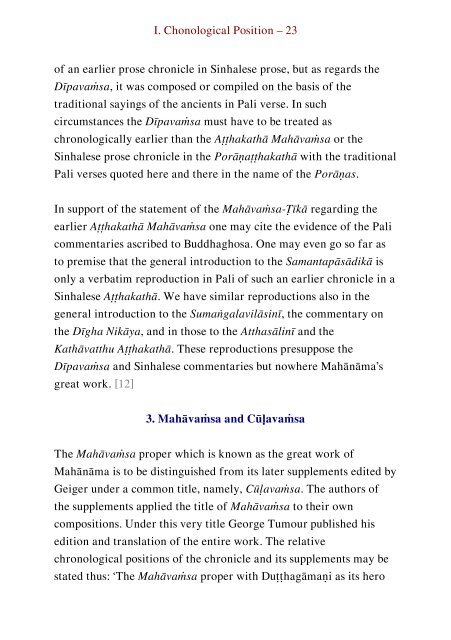On the Chronicles of Ceylon
A judicious appraisal of the various Chronicles that were written in Sri Lanka, assessing their chronology, literary and historical character.
A judicious appraisal of the various Chronicles that were written in Sri Lanka, assessing their chronology, literary and historical character.
- No tags were found...
You also want an ePaper? Increase the reach of your titles
YUMPU automatically turns print PDFs into web optimized ePapers that Google loves.
I. Chonological Position – 23<br />
<strong>of</strong> an earlier prose chronicle in Sinhalese prose, but as regards <strong>the</strong><br />
Dīpavaṁsa, it was composed or compiled on <strong>the</strong> basis <strong>of</strong> <strong>the</strong><br />
traditional sayings <strong>of</strong> <strong>the</strong> ancients in Pali verse. In such<br />
circumstances <strong>the</strong> Dīpavaṁsa must have to be treated as<br />
chronologically earlier than <strong>the</strong> Aṭṭhakathā Mahāvaṁsa or <strong>the</strong><br />
Sinhalese prose chronicle in <strong>the</strong> Porāṇaṭṭhakathā with <strong>the</strong> traditional<br />
Pali verses quoted here and <strong>the</strong>re in <strong>the</strong> name <strong>of</strong> <strong>the</strong> Porāṇas.<br />
In support <strong>of</strong> <strong>the</strong> statement <strong>of</strong> <strong>the</strong> Mahāvaṁsa-Ṭīkā regarding <strong>the</strong><br />
earlier Aṭṭhakathā Mahāvaṁsa one may cite <strong>the</strong> evidence <strong>of</strong> <strong>the</strong> Pali<br />
commentaries ascribed to Buddhaghosa. <strong>On</strong>e may even go so far as<br />
to premise that <strong>the</strong> general introduction to <strong>the</strong> Samantapāsādikā is<br />
only a verbatim reproduction in Pali <strong>of</strong> such an earlier chronicle in a<br />
Sinhalese Aṭṭhakathā. We have similar reproductions also in <strong>the</strong><br />
general introduction to <strong>the</strong> Sumaṅgalavilāsinī, <strong>the</strong> commentary on<br />
<strong>the</strong> Dīgha Nikāya, and in those to <strong>the</strong> Atthasālinī and <strong>the</strong><br />
Kathāvatthu Aṭṭhakathā. These reproductions presuppose <strong>the</strong><br />
Dīpavaṁsa and Sinhalese commentaries but nowhere Mahānāma’s<br />
great work. [12]<br />
3. Mahāvaṁsa and Cūḷavaṁsa<br />
The Mahāvaṁsa proper which is known as <strong>the</strong> great work <strong>of</strong><br />
Mahānāma is to be distinguished from its later supplements edited by<br />
Geiger under a common title, namely, Cūḷavaṁsa. The authors <strong>of</strong><br />
<strong>the</strong> supplements applied <strong>the</strong> title <strong>of</strong> Mahāvaṁsa to <strong>the</strong>ir own<br />
compositions. Under this very title George Tumour published his<br />
edition and translation <strong>of</strong> <strong>the</strong> entire work. The relative<br />
chronological positions <strong>of</strong> <strong>the</strong> chronicle and its supplements may be<br />
stated thus: ‘The Mahāvaṁsa proper with Duṭṭhagāmaṇi as its hero


















